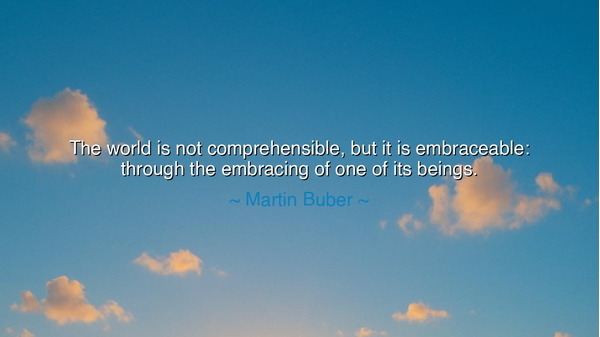
The world is not comprehensible, but it is embraceable: through
The world is not comprehensible, but it is embraceable: through the embracing of one of its beings.






When Martin Buber wrote, “The world is not comprehensible, but it is embraceable: through the embracing of one of its beings,” he gave voice to a truth as ancient as humanity itself — that the mystery of existence cannot be solved by the mind, but it can be touched by the heart. Buber, a philosopher of relationships, taught that understanding life does not come from dissecting it, but from entering into communion with it. To embrace another being — human, animal, or even the quiet presence of nature — is to touch the infinite in a single moment of connection.
In this sentence lies the essence of Buber’s lifelong teaching, expressed in his great work I and Thou. He believed that the world reveals itself not through logic or analysis, but through relationship — the living encounter between “I” and “Thou.” When one person truly meets another, without judgment, without use, without masks, the walls of separation fall away. In that moment, life itself becomes embraceable, even if it remains incomprehensible. The universe may be vast, uncertain, and beyond human reason, but through love, empathy, and authentic encounter, we find meaning.
The ancients knew this truth well. The mystics of every faith taught that to know the divine is not to grasp it, but to be in union with it. The Taoists said, “The Tao that can be spoken is not the eternal Tao,” yet they found peace by living in harmony with all things. So too does Buber teach us that the secret of the world is not hidden in knowledge, but in relationship — in the simple, sacred act of being present with another life. When you embrace a being, you do not solve the world’s mystery; you join it.
Consider the story of St. Francis of Assisi, who walked among the poor, the sick, and even the beasts of the field, greeting each with love. He did not understand the vastness of creation — he did not need to. By embracing the leper, by speaking gently to the wolf, by calling the sun his brother and the moon his sister, Francis entered the truth that Buber spoke centuries later. Through each act of connection, he embraced the world itself. His love became a bridge between the unknowable and the known, between humanity and the divine.
Buber’s wisdom challenges the modern soul, for we live in an age that worships comprehension. We measure, categorize, and seek to control the world — and in doing so, we often lose our sense of wonder. Yet the heart’s wisdom whispers differently: the world is not meant to be conquered, but experienced. To embrace another person, to hold their pain as your own, to look into their eyes and see not a stranger but a mirror of your own being — that is the closest one can come to understanding the mystery of life. For in that embrace, the incomprehensible becomes holy.
In truth, the embrace is the most ancient form of prayer. It asks nothing, proves nothing, but joins what was once divided. When you hold another being — in compassion, forgiveness, or love — you affirm that though the world may not make sense, it is still beautiful. In that act, you recover your place within the living fabric of existence. You realize that to be human is not to know everything, but to feel deeply, to connect, to belong.
So, my child, remember this: do not seek to understand the world before you have learned to embrace it. Knowledge without love is hollow; love without understanding is still divine. When life confuses you, when reason fails, find one being — a friend, a tree, a child, even an animal — and embrace it wholly. Let that moment remind you that existence, though vast and unfathomable, is not foreign to you. You are part of its mystery.
Thus, as Martin Buber teaches, “The world is not comprehensible, but it is embraceable.” You cannot think your way into truth; you must love your way into it. The heart reaches where the mind cannot go. Embrace freely, listen deeply, and live as one who knows that meaning is not found in solving the world, but in belonging to it — one heartbeat, one soul, one sacred encounter at a time.






AAdministratorAdministrator
Welcome, honored guests. Please leave a comment, we will respond soon